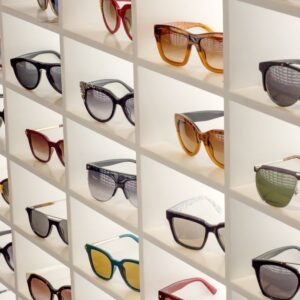If you need prescription sunglasses, you must visit an optometrist or ophthalmologist to examine your eyes and get a prescription for glasses. You can then take this prescription to an optician or eyewear retailer to make the lenses into a pair of sunglasses.
Some places may even offer a “sunglasses” option when getting your prescription filled, which will include a darker tint on the lenses to reduce glare and protect your eyes from the sun’s UV rays.
Here’s a list of the top 10 reasons why you might need prescription sunglasses.
Protecting Your Eyes from the Sun’s UV Rays
Protecting your eyes from the sun’s ultraviolet (UV) rays is vital to maintain good eye health. UV radiation can cause damage to the eyes that can lead to conditions such as cataracts, macular degeneration, and even skin cancer on the eyelids. Wearing sunglasses that provide 100% UV protection can help to block out these harmful rays and protect your eyes from damage.
In addition to correcting vision, prescription sunglasses also provide UV protection for the eyes. It is also essential to wear a wide-brimmed hat or cap to protect the eyes and surrounding skin from sun exposure.
Avoiding Glare and Discomfort From Bright Light
Glare from bright light can cause discomfort and difficulty seeing, especially while driving or participating in outdoor activities. Wearing sunglasses with polarized lenses is essential to avoid glare and discomfort from bright light.
Polarized lenses can help to improve visibility, reduce eye strain, and prevent headaches caused by bright light. These lenses are designed to reduce glare by blocking intense reflections from surfaces such as water, snow, and pavement. Additionally, certain coatings, such as anti-glare coating, can be applied to prescription glasses to reduce glare.
Another way to avoid glare and discomfort from bright light is to choose sunglasses with large frames or wraparound styles that can prevent light from entering from the side. It’s also essential to choose a lens color that can help to reduce glare. Grey, brown, or green lenses can help to reduce glare by providing a neutral color balance that does not distort colors.
Preventing Visual Fatigue & Headaches
Prescription sunglasses can also help prevent visual fatigue and headaches by correcting a person’s vision issues, such as nearsightedness, farsightedness, or astigmatism. By correcting these issues, prescription sunglasses can help reduce eye strain and improve visual clarity, preventing fatigue and headaches.
Additionally, prescription sunglasses with polarized lenses or anti-glare coatings can help reduce glare and improve visibility, further preventing visual fatigue and headaches.
It is also important to note that good fit and comfortable frames are essential to preventing visual fatigue and headaches. Ill-fitting frames can cause pressure points on the face and ears, leading to discomfort and headaches.
It’s also worth noting that if you experience visual fatigue, headaches, or other symptoms, you should consult your optometrist or ophthalmologist to rule out any underlying issues.
Improving Depth Perception & Visual Clarity
Prescription sunglasses can improve depth perception and visual clarity by correcting any vision issues that a person may have, such as nearsightedness, farsightedness, or astigmatism. When a person has a prescription for glasses, the lenses are made to correct their specific vision problem, which can improve visual clarity and depth perception.
Some prescription sunglasses can also have different lens coatings or tints to enhance visual clarity and depth perception. For example, polarized lenses can help reduce glare and improve visibility, making it easier to see objects in the distance and judge distances more accurately.
Photochromic lenses can also help to improve visual clarity by automatically adjusting to different lighting conditions, making it easier to see objects in bright sunlight or low-light situations.
Reducing Digital Eye Strain & Blue Light Exposure
Prescription sunglasses can help reduce digital eye strain and blue light exposure by correcting vision issues and reducing glare. Digital eye strain is a common problem caused by the prolonged use of digital devices, such as computers, smartphones, and tablets.
Symptoms of digital eye strain include dry eyes, fatigue, and headaches. Correcting any vision issues with prescription sunglasses can reduce the strain on their eyes and prevent these symptoms.
Some prescription sunglasses can also have special lens coatings or tints that can block blue light, the type of light emitted by digital devices. Blue light has been shown to disrupt the body’s natural sleep-wake cycle and can cause eye strain, fatigue and headaches. By blocking blue light, these special lenses can help to reduce digital eye strain and prevent these symptoms.
If you experience digital eye strain or blue light exposure symptoms, it is better to consult with your optometrist or ophthalmologist; they can advise you on other ways to reduce digital eye strain and recommend the best lens options for your individual needs.
Your Eyesight has Recently Changed.
If your eyesight has recently changed, you must visit an optometrist or ophthalmologist to examine your eyes and update your prescription. This is important because an outdated prescription can lead to eye strain, fatigue, and headaches. Additionally, regular sunglasses may not provide adequate vision correction or UV protection if your eyesight has changed.
It is vital to wear prescription sunglasses that provide 100% UV protection to maintain good eye health and prevent cataracts and macular degeneration.
Prescription sunglasses can provide the necessary correction for your updated prescription, ensuring you can see clearly and comfortably. They also provide the added benefit of protecting your eyes from the sun’s harmful UV rays.
Increased Eye Comfortability
Prescription sunglasses can increase eye comfort by providing the necessary correction for any vision issues, such as nearsightedness, farsightedness, or astigmatism. When a person has a prescription for glasses, the lenses are made to correct their specific vision problem, which can improve visual clarity and reduce eye strain. This can lead to increased comfort for the eyes as they are not working as hard to see clearly.
Additionally, prescription sunglasses with polarized lenses or anti-glare coatings can also help reduce glare and improve visibility, which can further increase eye comfort by reducing the amount of light that enters the eyes and reducing glare caused by surfaces such as water, snow, and pavement.
Good fit and comfortable frames are essential for increasing eye comfort. Ill-fitting frames can cause pressure points on the face and ears, leading to discomfort. So, choosing frames that fit well and feel comfortable wearing them is crucial.
The lens material also plays a role in comfortability; for example, the high-index lenses are thinner and lighter than regular plastic lenses, reducing the weight of the glasses on the nose and ears and providing a more comfortable fit.
Minimize the Effects of Wind Gusts on Eyes
Prescription sunglasses can help to minimize the effects of wind gusts on the eyes by protecting them from wind and debris. The frames of the sunglasses can act as a barrier to block the wind from directly hitting the eyes, preventing the eyes from feeling dry, irritated, or teary.
Additionally, prescription sunglasses with wrap-around frames or larger lenses can provide additional protection by covering more of the eyes and surrounding area. This can help to prevent wind and debris from entering the eyes from the sides, which can be especially helpful for people who are involved in outdoor activities such as cycling or windsurfing.
In addition, some prescription sunglasses can also have special lens coatings or tints that can reduce glare, improve visibility, and increase eye comfort. For example, polarized lenses can help reduce glare caused by the wind and improve visibility in bright light conditions, making it easier to see objects in the distance and judge distances more accurately.
Protect Against Eye Injury
Prescription sunglasses can help to protect against eye injury by providing a barrier to block harmful debris, dust, and small objects from entering the eyes. The frames of the sunglasses can act as a barrier to block these particles from directly hitting the eyes, preventing eye injury.
Additionally, prescription sunglasses with shatterproof or impact-resistant lenses can provide additional protection by reducing the risk of the lenses breaking or cracking, which can help to prevent eye injury from sharp or jagged pieces of glass.
It’s also worth noting that if you participate in activities or sports that have a higher risk of eye injuries, such as cycling, skiing, or hockey, you may want to consider prescription sunglasses with polycarbonate lenses, which are made of a material that is more impact-resistant than regular plastic or glass lenses.
Many prescription sunglasses can also have special lens coatings or tints that can increase visibility and improve eye comfort, making it easier to see objects in the distance and judge distances more accurately, reducing the risk of accidents.
Provide a Cosmetic Enhancement to Your Appearance
Prescription sunglasses can enhance your appearance as they come in various styles, shapes, and colors. They can also complement your facial features and personal style. They can also help you look great while providing vision correction and protection from UV radiation and glare.
Summary
There are several reasons why someone might need prescription sunglasses, including to correct vision problems such as nearsightedness or farsightedness, to protect the eyes from harmful UV rays, and to reduce glare while driving or participating in outdoor activities.
Additionally, prescription sunglasses can be helpful for individuals who are sensitive to light or have certain medical conditions such as cataracts or macular degeneration.
It is always best to consult an eye doctor to determine if prescription sunglasses are necessary for your specific needs.






